The velvet of Tessitura Luigi Bevilacqua: a caress born in the nineteenth century
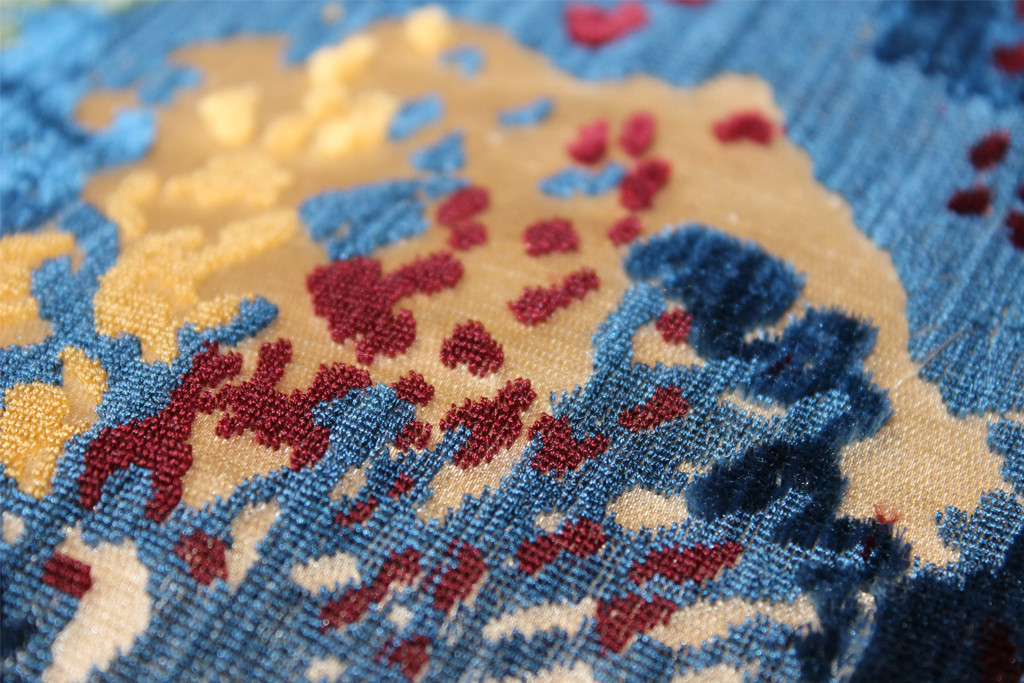
One of the oldest and largest
Jacquard weaves in Europe
As a first look at the origins of Venetian glamour, I will tell you the story of a fabric that is still realized today in Venice according to nineteenth century techniques, a fabric full of history, which is spun by hand with slowness, passion and great skill. Precious enough to be woven with pure gold threads. But a fabric that knows how to reinvent itself and will be the protagonist of the A/W 2018-2019 fashion. A soft and caressing surface, with intense and vibrant colors, is its distinctive mark. I am obviously talking about velvet.
In ancient times its weaving technique was born in the East, but already in the thirteenth century its production was also imported in Italy, especially in the cities of Lucca, Venice, Genoa, Florence and Milan, which at that time become centers of excellence for the production of velvet and sell this fabric throughout the European continent. Later the Flemish start weaving it, but the velvets of Bruges only in the sixteenth century will begin to be considered not inferior to the Italian ones.[Footnote 1]
To know the secrets of the beauty of this fabric I went to visit for you the Luigi Bevilacqua atelier, where you can see the birth of velvet from the nineteenth-century looms according to original techniques.
Only Venice, knows how to preserve the treasures of the past without a solution of continuity with the contemporary life of the city.[Footnote 2]
I still have in my eyes the depth of the colors of the fabrics and the image of the thousands of threads and spools anchored in ancient wooden looms. “In the current location [of the atelier], at 1320 Santa Croce, in Venice, there are looms, all original eighteenth-century pieces: the same machines belonging to the Scuola della Seta [Silk School of the Serenissima] and bought by Luigi [Bevilacqua] in 1875. “[Footnote 3]The Bevilacqua atelier is in fact one of the oldest and largest Jacquard weaves in Europe still active.
The beginning of its history dates back to 1499, as can be read in the cartouche of the painting “San Marco dragged into the Synagogue” by Giovanni Mansueti, a pupil of Gentile Bellini, where are listed the names of the commissioners of the work among which is indicated “Giacomo Bevilacqua, weaver”, an ancestor of Luigi Bevilacqua.
The Bevilacqua atelier is located in Fondamenta di San Zan Degolà (or San Giovanni Decollato [Footnote 4]), between Campo San Giacomo dell’Orio and the Grand Canal. It can be reached through short and narrow streets (in Venice called “calli”), pleasantly unpopulated by mass tourism.
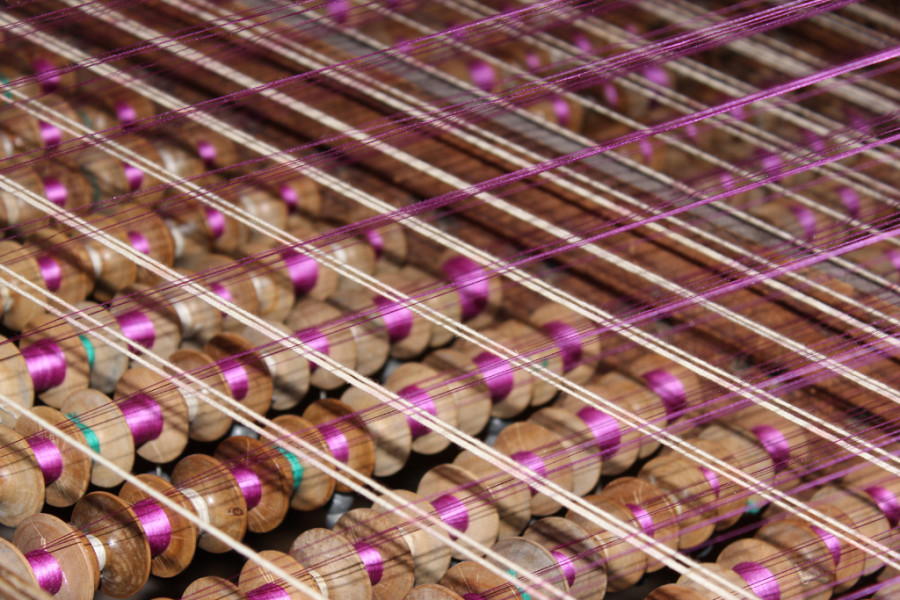
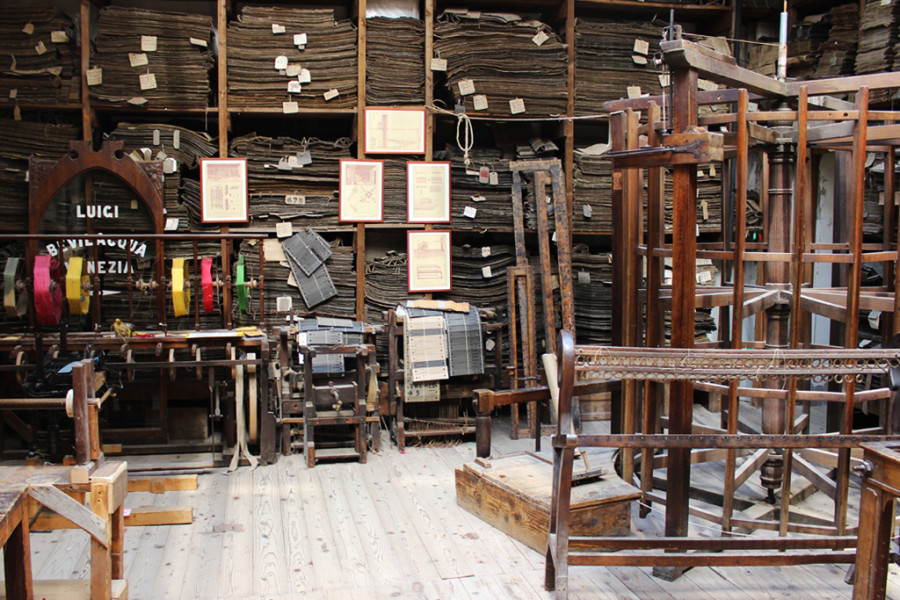
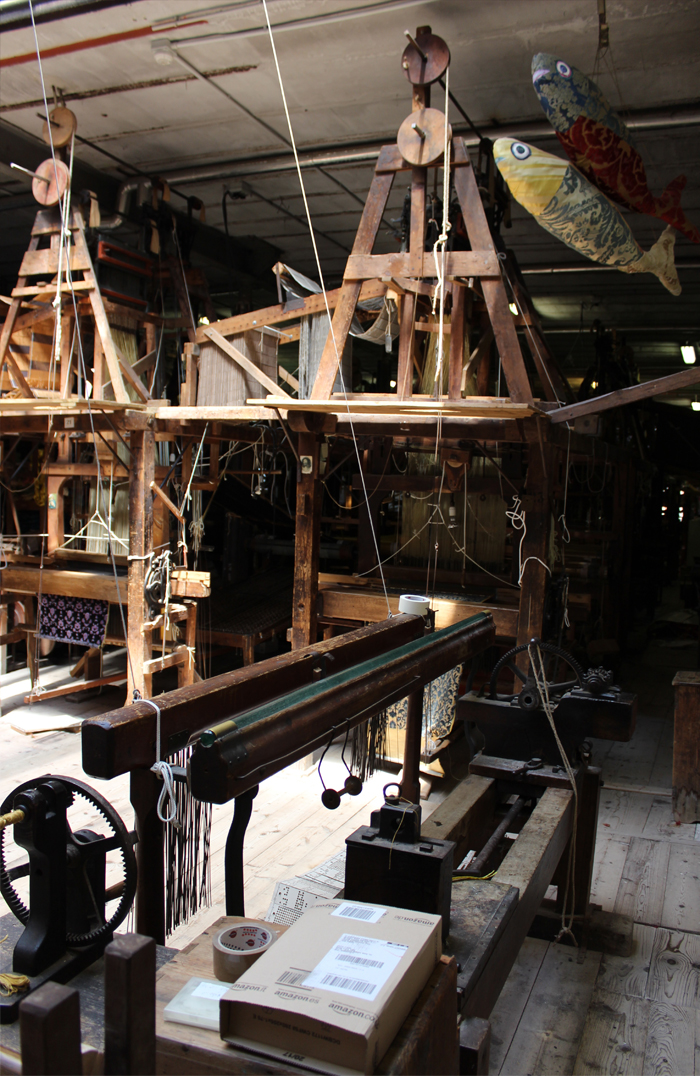
I arrived there in a late sunny and warm morning. To welcome me the dr. Alberto Bevilacqua, managing director of the family business, an entrepreneur and craftsman of yesteryear, in love and proud of his work.[Footnote 5].
The Luigi Bevilacqua atelier is located on the ground floor of a typically two-storey Venetian building. From the internal company store, he immediately took me to the laboratory, which is a small wonder: wooden floors, shelves that collect the secrets of a centenary archive and a dozen original eighteenth-century looms where some spinners are at work. The atmosphere is cosy, the light is suffused and comes from the lamps placed above the worktop of the looms, from which the fabrics come out very slowly and sumptuously.
Maddalena Mometti: What are the fabrics that are mainly made in the Venetian atelier?
Alberto Bevilacqua: We produce two types of velvets: cut velvets and soprarizzo velvets (“over-the-curls”). The cut velvet is a velvet that has only one level: on the loom are placed horizontal irons that have grooves, the weaver passes inside the rebotto, an instrument with a razor blade that passes into the grooves of the irons and cut the velvet threads. In this way a dense down forms on the right side of the fabric. The velvet hair is always made of silk, while the ground can be in cotton or silk. On the other hand, soprarizzo velvet has two levels: a higher part which is the cut one darker and higher velvet and the hedgehog, which is the part that is folded and remains lower and lighter.
Note: If the cut velvet can also be made mechanically, the particular technique required to make soprarizzo velvet allows it to be woven only manually. Luigi Bevilacqua company produces fine fabrics for furniture and haute couture: in addition to velvets, it also produces damasks, lampases, brocatelles. The manual production (based in Venice) in the thirties was accompanied by a mechanical production that is now located on the mainland, near Conegliano.
Maddalena Mometti: How is the design of the fabrics defined?
Alberto Bevilacqua: The definition of the design of a fabric begins with a rough sketch, which is then drawn on a 1:1 scale on millimeter paper. This phase is called “messa in carta” (“putting in paper”). Subsequently, the drawing on paper is “translated” into punched cards in which each half millimeter of the design corresponds to one of the perforated cards that will be read by the Jacquard looms. The frame is prepared by mounting the boards on it and arranging the coils with the desired color threads. For the realization of a fabric, 1600 coils divided between yarns for the hair and for the ground may also be necessary.
Once the frame is ready, the warp is prepared which is then fixed to the loom through a cylinder and production can start. Setting up a frame, depending on the complexity, may require the work of one or two weavers for a period from one to six months. Moreover, every 15-20 meters of fabric, we need to redo the warp and attach the new piece with the old: an operation of great complexity that requires considerable precision in order not to point out the junction point between the two parts.
Note: The introduction of jacquard machines is about 1806. The Jacquard loom is considered an ancestor of the first computers because it is a machine that can be programmed through the reading of punched cards.
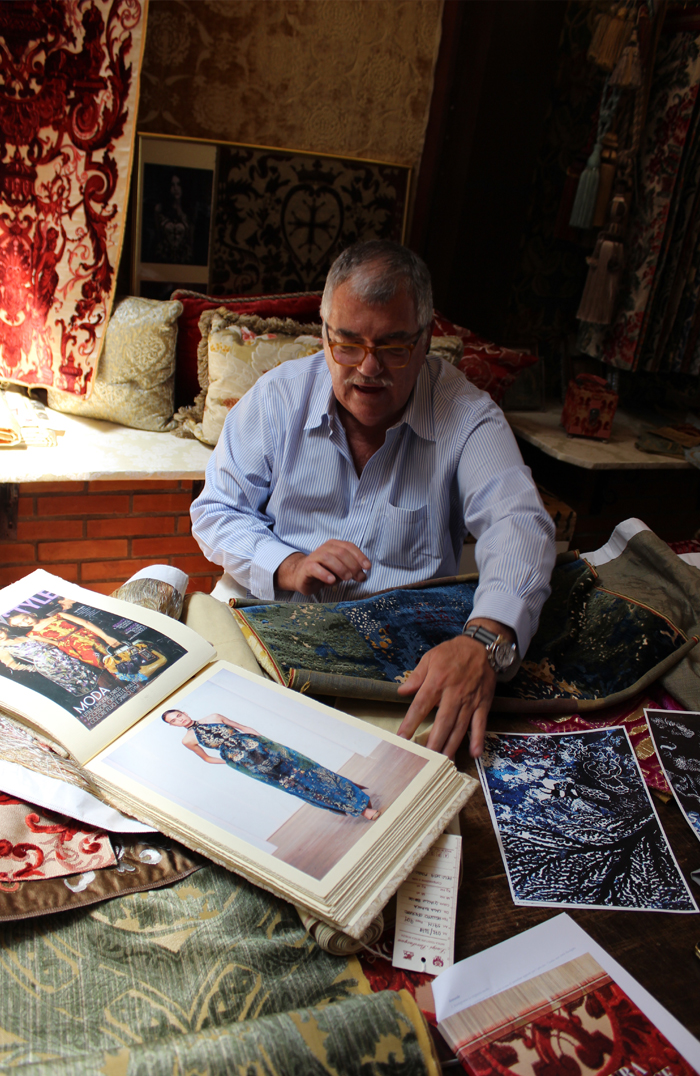
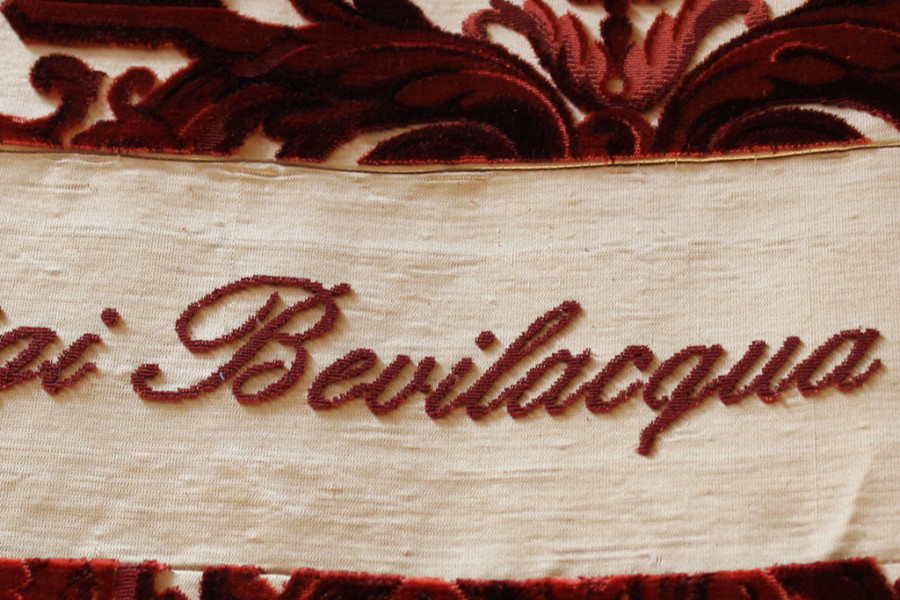
Maddalena Mometti: Is it possible to choose any yarn color?
Alberto Bevilacqua: The customer decides what colors he wants. We buy dyed silk in packages. If we are asked for a special color instead, we will dye it with industrial techniques.
Maddalena Mometti: Historically, did the Luigi Bevilacqua weave produce more velvet for the furniture or fashion industry?
Alberto Bevilacqua: The production of velvet was introduced in Venice around 1300. The invention of the technique of weaving velvet is due to Lucca and the Sicilians. During the period of the struggles between Guelphs and Ghibellines, some Lucchesi weavers, by political dissidence, moved to Venice asking for political asylum and thus bringing their knowledge to the city.
Before velvet, in Venice there was the prodoction of another fabric that was called sciamito.
In 1500, the period of maximum splendor of weaving, there were about 6000 frames in Venice that worked velvet, one of the most important economic activities of the time. Thanks to the testimonies of the time, and also simply observing the paintings of Veronese and Tiziano, it is possible to notice how the clothes of the upper classes were in velvet, while the walls of the buildings were covered with the same fabric.
Maddalena Momenti: And now to which destinations is your production directed?
Alberto Bevilacqua: Currently, the big commissions are obviously destined to furnishing but it is a period in which haute couture has a renewed interest in fine velvet. We work with the biggest fashion brands, which require both hand-made velvets and those made mechanically. In addition, I have often seen in the magazines some famous people and recognize in their clothes our fabrics or in their houses photographed on Architectural Digest.
Handmade velvet can be recognized because it has a much wider range of color shades as well as a variation in the size of the hair height. The French call velvet soprarizzo ciselée which means chiselled, precisely because it has many reflections and finishes as if it were worked with chisel.
Maddalena Mometti: But where do famous people buy your fabrics?
Alberto Bevilacqua: Famous customers usually buy our fabrics from designers. The designer sometimes comes directly to us from Venice or goes to our distributor in New York and advises the customer on what to buy to make the final product for him.
Maddalena Mometti: The return of fashion to prestigious fabrics, like yours, in your opinion, from what is determined? In recent years, controversy has often arisen concerning the fact that haute couture garments, although very beautiful and expensive, were made with fabrics that are not always of high quality.
Alberto Bevilacqua: I believe that our customers turn to us for the desire to stand out. For example, one of the famous designers we met, had already worked at the Lisio Foundation [Footnote 6] in Florence where they have antique manual looms for the realization of brocade, before getting to know each other. Later he decided to start a small production of clothes using a fabric that we have made on his exclusive design.
The difficulty we sometimes encounter in working in the fashion industry is linked to the processing times of our products, which struggle to fit the demands of fashion system speed. However, collaborating together we have been able to give life (and we continue to do so) to some very beautiful projects, starting also from the fifties when, for example, in 1953 Roberta di Camerino chose our velvet to make his Bagonghi.
We also made fabrics with real gold and silver threads, [Footnote 7] as for example in 2012 for clothes collection of a famous fashion house.
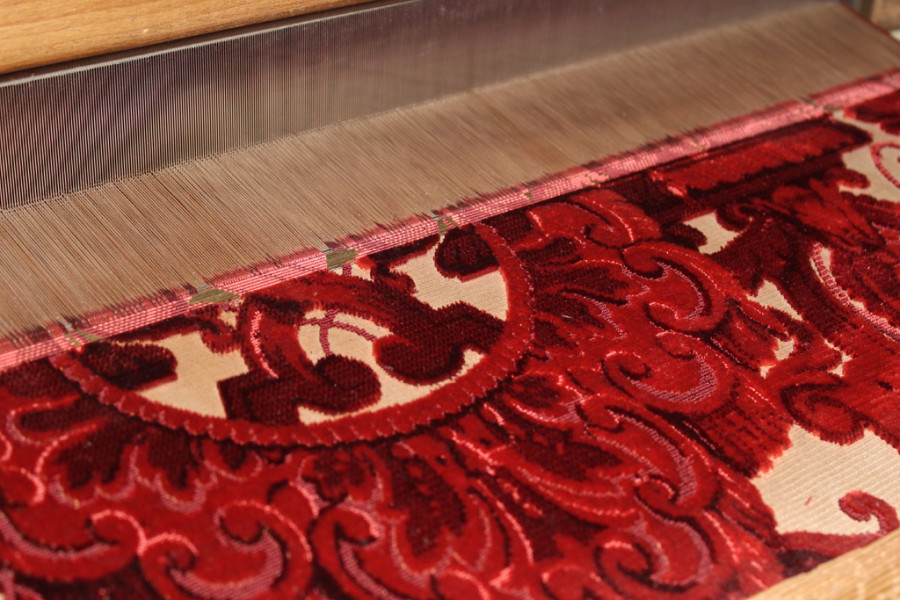
FOOTNOTES
[1] Vogue Encyclo, sub voce velluto, http://www.vogue.it/news/encyclo/tessuti/v/il-velluto
[2] Official web site of Tessitura Luigi Bevilcqua, https://www.luigi-bevilacqua.com, last accessed on April 30 2018
[3] Excerpt from the catalog: Tessitura Made in Venice. Luigi Bevilacqua. Antica tessitura in Venezia dal 1499. 2016. Arcari S.r.l Industria Grafica. Mogliano (TV)
[4] Decollato refers to St. John the Baptist who was beheaded.
[5] Interview with Alberto Bevilacqua, by Maddalena Mometti, May 30 2017, at Tessitura Luigi Bevilacqua, S.Croce 1320, Venice, Italy
[6] The Fondazione Arte della Seta Lisio is an association that aims to pass on the art of hand weaving in silk and precious metals.
https://www.fondazionelisio.org/it/
[7] Fabrics using silk threads combined with threads of precious metals such as gold and silver are called auroserici.
IMAGES
The images are published by kind permission of Tessitura Luigi Bevilacqua. Starting from above:
[image 1] Detail of Coralli soprarizzo velvet made by Tessitura Luigi Bevilacqua based on the design of the Yiqing Yin designer; composition: hair: 100% silk, ground: 100% silk; photo by Maddalena Mometti
[image 2] Detail of the spools mounted on one of the original eighteenth century looms of Tessitura Luigi Bevilacqua; photo created by Maddalena Mometti
[image 3] Photo of the interior of Luigi Bevilacqua atelier with a warping machine on the right, the machine with which the warp is prepared before loading it onto the loom; photo created by Maddalena Mometti
[image 4] Photo of the inside of Luigi Bevilacqua atelier; photo created by Maddalena Mometti
[image 5] Portrait of dr. Alberto Bevilacqua; photo created by Maddalena Mometti
[image 6] Detail of the Grottesche soprarizzo velvet made by Tessitura Luigi Bevilacqua; composition: hair: 100% silk, ground: 100% silk; photo created by Maddalena Mometti
[image 7 ] Detail of the Grottesche soprarizzo velvet made by Tessitura Luigi Bevilacqua; composition: hair: 100% silk, ground: 100% silk; photo created by Maddalena Mometti


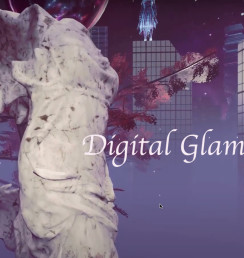

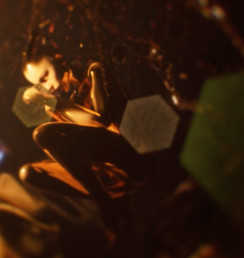
I was studying some of your posts on this internet site and I think this website is very informative ! Retain putting up.
I like this weblog very much, Its a rattling nice spot to read and obtain info .
Appreciate it for this terrific post, I am glad I detected this web site on yahoo.
Aw, this was a really nice post. In concept I wish to put in writing like this moreover – taking time and precise effort to make a very good article… but what can I say… I procrastinate alot and not at all seem to get something done.